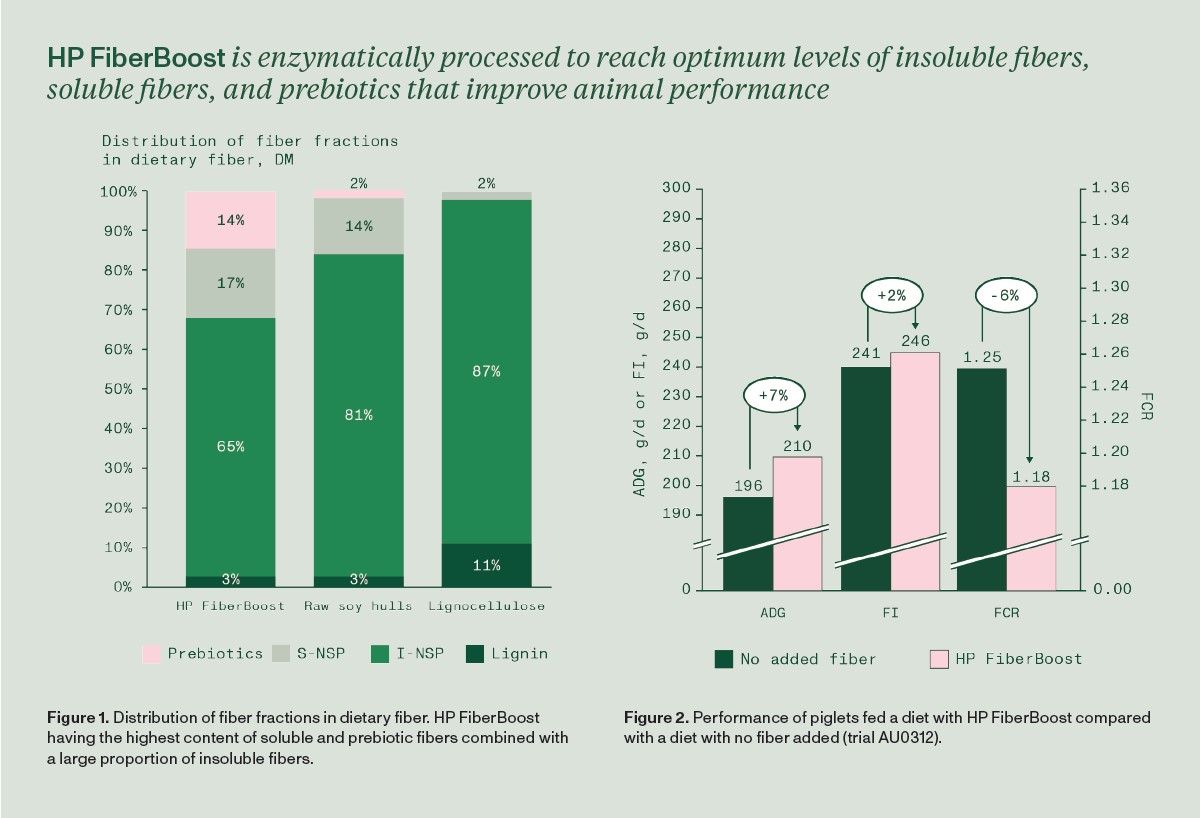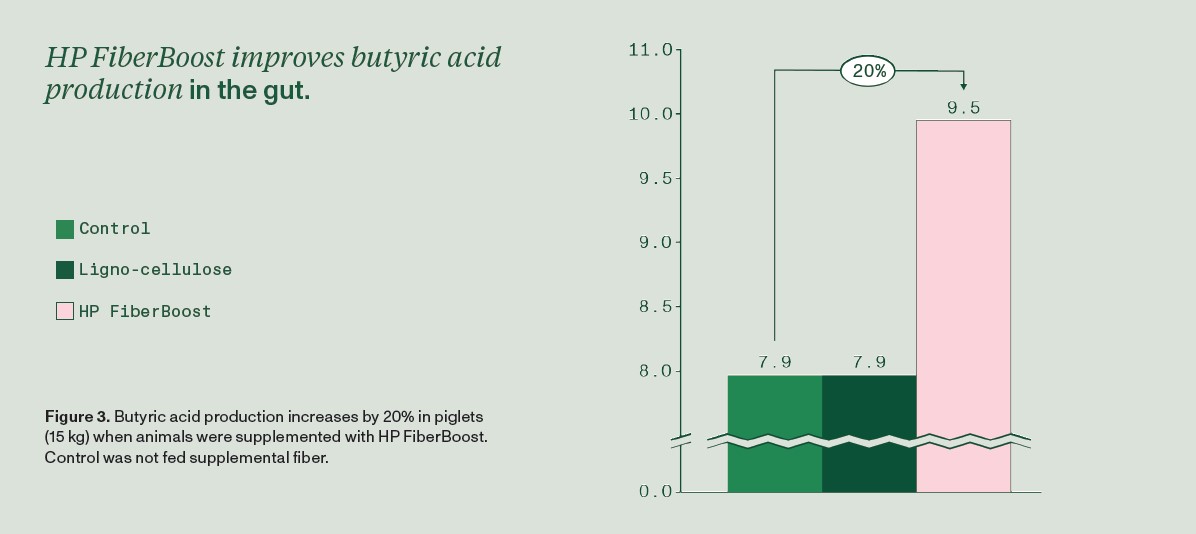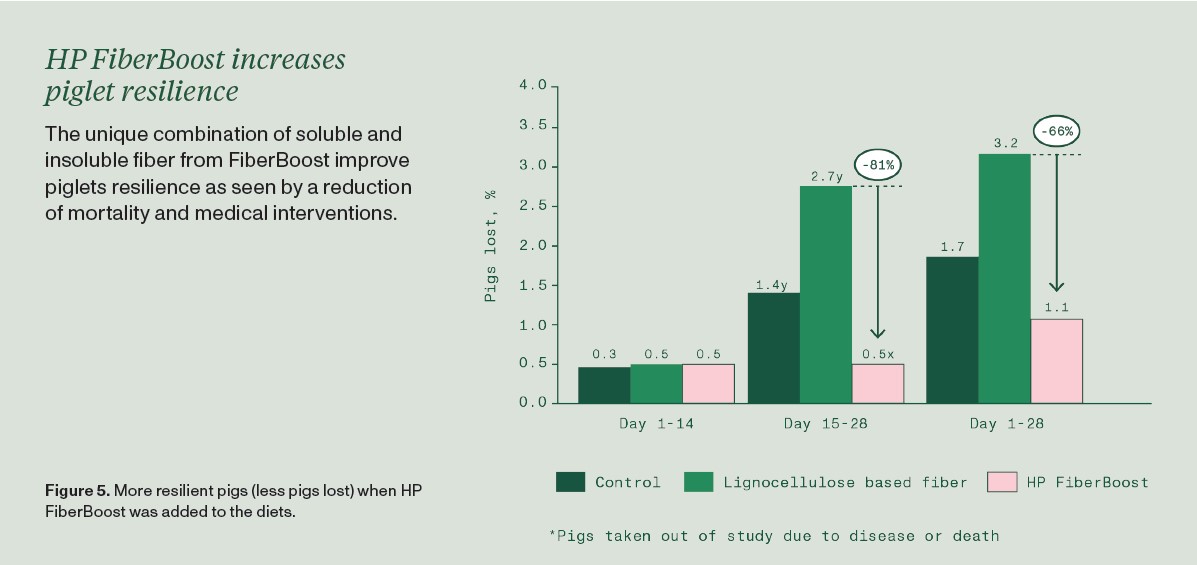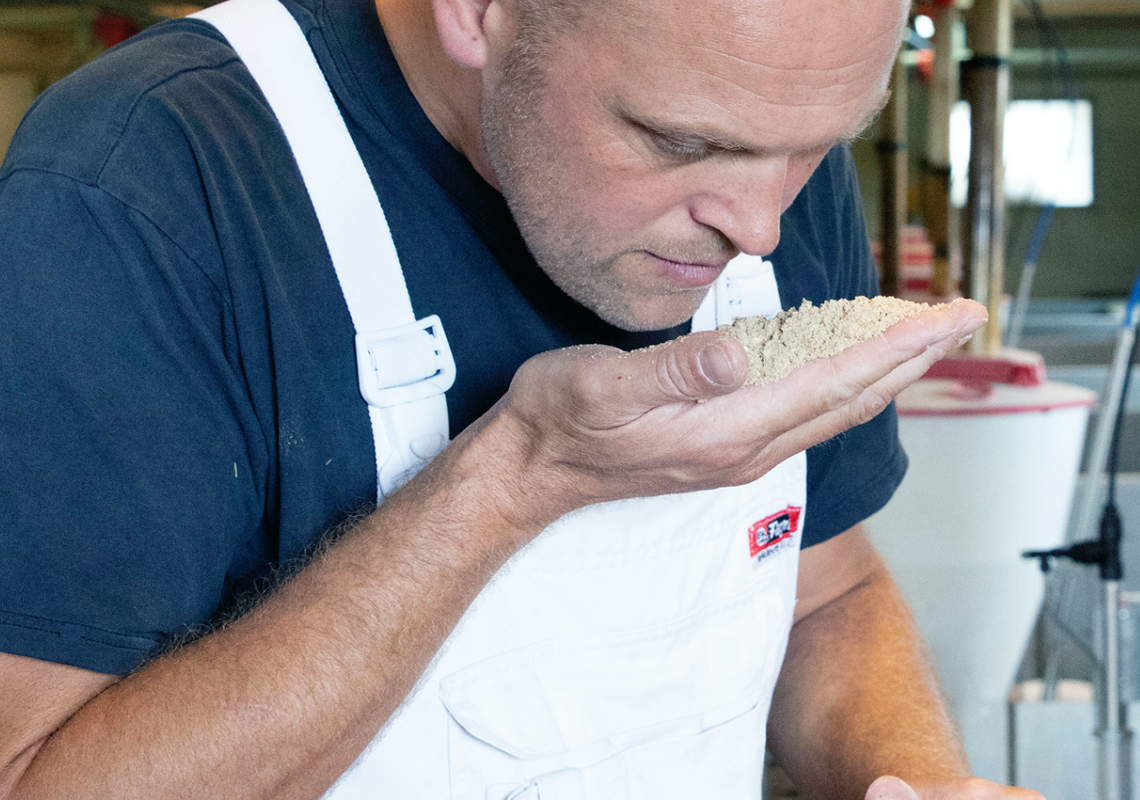HP FiberBoost, the ideal functional fiber with prebiotic properties
Next generation fibers stimulate gut health and modulate the microbiota
Adding the unique combination of soluble and insoluble fiber with prebiotic properties from FiberBoost to the diets of weaned pigs improves:
- Fecal consistency
- Gut health and development
- Feed intake
- Transition between diets
- Growth
It reduces the need for medical interventions and enables the use of weaner diets with high crude protein levels. HP FiberBoost contains enzymatically processed soy hulls. This processing method reduces the content of antinutritional factors and alters the fiber composition. As a result, HP FiberBoost has a better fiber profile and more prebiotic carbohydrates than soy hulls.

Figure 1. Distribution of fiber fractions in dietary fiber. HP FiberBoost having the highest content of soluble and prebiotic fibers combined with a large proportion of insoluble fibers.
Figure 2. Performance of piglets fed a diet with HP FiberBoost compared with a diet with no fiber added (trial AU0312).
The benefits of fibers
The potential benefits of fiber depend on the composition of the fiber fractions. Dietary fiber can be divided in insoluble -and soluble fibers. The insoluble (or inert) fibers contain insoluble non- starch polysaccharides (I-NSP) and lignin which are almost not degraded in pigs.
The use of insoluble fiber in pig diets contributes to the secretion of digestive enzymes, stimulates peristaltic activity, reduces the adhesion of pathogenic bacteria to the gut wall and improves, due to the water holding capacity, fecal consistency.
The soluble fiber fraction reaches the hind gut intact and serves as a nutrient source for the microbiota that inhabit this part of the digestive tract.
Especially the bacteria that are considered beneficial for gut health like lactic acid producing bacteria and bifidum bacteria are capable of secreting fiber digesting enzymes, which allows them to absorb the carbohydrates from within the fibers.
While digesting these carbohydrates from fiber they produce short chain fatty acids (SCFA’s) which have a positive effect on gut health.

Figure 3. Butyric acid production increases by 20% in piglets (15 kg) when animals were supplemented with HP FiberBoost. Control was not fed supplemental fiber.

Table 1. Day 0-41 performance of pigs fed one of four dietary treatments. Note: ADG = average daily gain; ADFI = average daily feed intake; FCR = feed conversion ratio; Uniformity calculated as coefficient of variation (CoV; mean/sd*200). Superscripts letters (a, b, c) indicate significant differences (p<0.05).
*Mortality rate: main effect of HP FiberBoost addition is a near-significant trend (p=0.06); Uniformity: for main effect of HP FiberBoost addition p=0.15.
HP FiberBoost increases piglet resilience
The unique combination of soluble and insoluble fiber from FiberBoost improve piglets resilience as seen by a reduction of mortality and medical interventions.

Figure 5. More resilient pigs (less pigs lost) when HP FiberBoost was added to the diets.
HP FiberBoost reduces the risk of protein fermentation in the hindgut
The microbiota that use the prebiotics of HP FiberBoost also like to consume undigested protein. This way less undigested protein remains avialable for the putrefactive bacteria that ferment protein in the hind gut. Protein fermentation is undesirable as it poses a serious risk for gut health.
To avoid protein fermentation, it has become quite common to reduce CP levels of weaner diets since the ban on pharmacological levels of ZnO became valid.
As a result, producers have seen a drop in weaner pigs’ growth. Supplementing weaned pigs with HP FiberBoost allows for normal levels of CP to be used which ensure good piglet growth and feed efficiency.
Product description
A pure fiber product based upon enzymatically processed soy hulls formulated specifically for dietetic use in pigs.
Benefits
- Increased feed intake
- Firm feces
- Improved gut health and development
- More resilient piglets
- Improved growth performance
- Enable the use of diets with high CP and energy
Product features
- Prebiotic carbohydrates
- Low viscosity
- Structural fibers that stimulate peristaltic movements
- Standardized composition
- Enzymatic-chemical analysis:
- Total-NSP 57%
- I-NSP 45%
- S-NSP 12%
- Prebiotics up to 10%
Health promoting recommendations
Around 4% crude fiber in final feed is recommended to get full health benefits of fiber.
A healthy and functioning gut
A healthy gut is the outcome of prebiotics contributing to production of the butyric acid directly in the lower gut. Local production takes advantage of all beneficial outcomes of butyric acid on intestinal villi development, gut epithelial integrity, and anti-inflammatory functions when produced in the lower gut.
Product features
- Prebiotic carbohydrates
- Low viscosity
- Structural fibers that stimulate peristaltic movements

Product benefits
Feed is the critical factor in animal production, accounting for up to 70% of total costs. Using HAMLET PROTEIN specialty soy proteins in young animal feed, you can optimize feed efficiency – and maximize your return on investment.
The key is their easy absorption by immature guts. Although added to feed for only a limited period in early life, our proteins have a strong carry-over effect on animal growth and performance. Feeding trials have documented a higher slaughter weight compared to animals fed standard soybean meal.
Our highly bioavailable proteins improve feed quality overall. That paves the way to reducing the total protein content – cutting the cost of your formulation.

